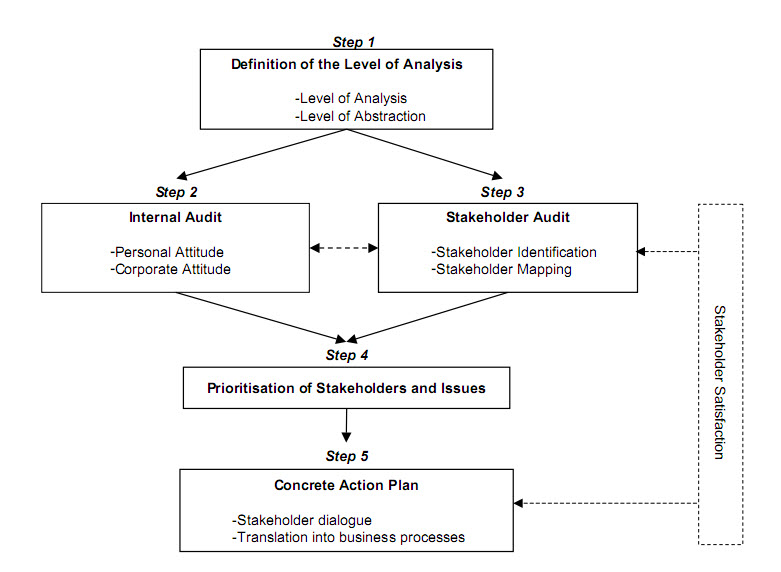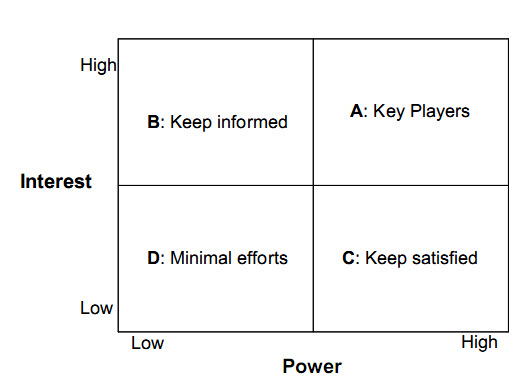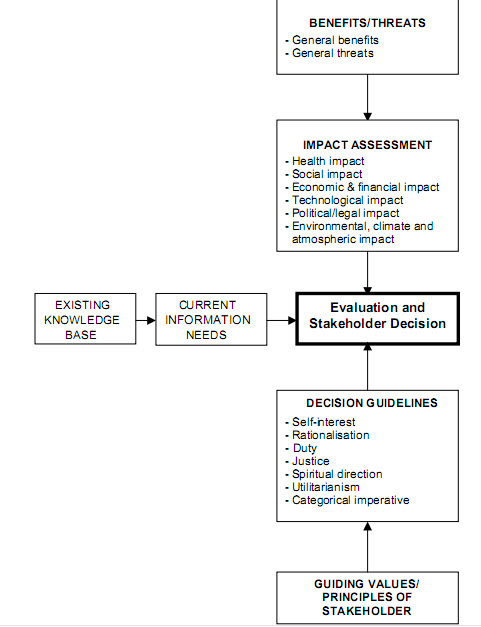21: The model: Trajectory framework for stakeholder management 
Step 1: Defining the level of analysis 分析层面的界定
Key questions
- What is the level of analysis: Group level? Country level? Company/site level? Or business unit/department level?
- What is the level of abstraction: Does the analysis address a specific problem or project within the company or the group? Or is it a general exercise aiming at integrating the stakeholder management approach or CSR in the business?
Step 2: Internal audit 内部审核
Key questions
- How does the organisation define CSR? What is its attitude towards CSR?
- What is the position of the company and its managers regarding CSR or the issue in question?
- What are the main internal drivers and barriers for stakeholder management and CSR?
- Why do we, as a company, need to tackle this issue/problem/project (e.g. reputation, public relations, advertising, trust building, performance, vision, innovation, management, employees)?
- What is the actual state of affairs with regard to stakeholder management (e.g. mission statement, stakeholder approach, ethical code)?
- What are the previous experiences related to CSR or in dealing with the specific problem/project?
Step 3: Stakeholder audit 利益相关方审核

Group A: the most important group of stakeholders with a high level of interest and power.
Group B: this group has a high level of interest in the company and its activities but has limited means to influence decisions or actions.
Group C: this group can present some difficulties. Although they behave passively they can have an enormous impact on the company or project.
Group D: this group is less important and requires minimal effort.
Key questions
- Who are the relevant stakeholders?
- What power do they exert on the company?
- What interest do they have in the company or company’s project/problem?
- What is the actual quality of the relationship of each of the stakeholders identified with the company (stakeholder satisfaction)?
Step 4: Prioritisation 排序
- What stakeholders should be focused on?
- What issues should be focused on?
- What activities, business units, departments should be focused on?
- What geographical area(s) should be focused on?
- What are the objectives with regard to the stakeholders?
Step 5: Action plan
- What concrete actions need to be carried out and with which stakeholder or group of stakeholders?
- How will the stakeholder dialogue be organised, what are the dialogue techniques that will be used and what will be the content of the dialogue?
- When does each action need to be carried out (start and end date)?
- What resources does it involve (capital, human, goods, technological, etc)?
- What are the expected outcomes of each of the actions?
- What are the expectations of the overall action plan?
- What impact has the action plan had on stakeholder satisfaction?
23: Fair Labour Association Model (briefly intro)
This model has been applied upon the suppliers of famous company, especially in labour intensive sectors like clothing and footwea (i.e. Nike, Adidas). Those suppliers are usually located in countries where labour regulations and their legal enforcement are less stringent than those in west European countries.Organisations of civil society have stepped in to promote improve-ents in such areas as human and labour rights and use a variety of strategies to try and ensure responsibility, accountability and transparency. Their demands are directed at both public and private bodies, but while public bodies have been slow to react, the private bodies, mainly multinational enterprises, started introducing private CSR initiatives in the 90s.
The approach to CSR in global supply chains puts the emphasis on monitoring the suppliers to compensate for the lack of an official labour inspection body. Among the more than 300 different CSR initiatives listed by the International Labour Organisation (ILO), the Fair Labour Association (FLA) is one of the most demanding. The FLA model, unlike other models, does not rely solely on one-off certifications but requires the total commitment of the brand-name companies to a programme of code implementation, internal monitoring and unannounced independent external monitoring. Under the FLA system, the brand is held responsible for the labour standards of their suppliers. Since experience has shown that CSR initiatives which concentrate solely on auditing fail to identify and cure the root causes of non-compliance, the FLA model integrates a system of monitoring, corrective action, third party complaints, and public reporting. The FLA Code of Conduct is based on the core labour standards of the ILO.
The FLA was formed in 1999 to promote respect for labour rights around the world. The FLA represents a multi-stakeholder coalition of companies, universities and NGOs. There are currently 16 brand-name companies participating fully in the FLA, including Adidas, Liz Claiborne, Nordstrom, Nike, Patagonia, Puma and Reebok and around 1000 university licensees who have included only their university production. With their membership in the FLA, these companies show their commitment to a rigorous programme of corporate social responsibility along their entire supply chain. 4000 facilities in over 80 countries are covered by the FLA programme, including 850 factories in China.
22: A Stakeholder Model for Emerging Technologies

The impact assessment section of the model allows the perceived impacts of the new technology to be examined in more detail. In addition to a generic ‘ther issue’ category, there are seven specific impact areas:
- Health impact ?the impact of the new technology on health, fitness and well-being;
- Social impact ?the impact on social issues, i.e. privacy, security, safety and freedom;
- Economic and financial impact ?the impact on general economic and financial conditions, i.e. earning power, financial profitability, financial security, economic development and competitiveness;
- Technology impact ?the impact on the development of new technology, i.e. further development of new knowledge, products or processes;
- Political and legal impact ?the impact on political legal conditions, i.e. need for political involvement, intervention, legislation;
- Environmental impact ?climate and atmospheric impacts;
- Cultural impact ?the impact on cultural and sub-cultural factors, i.e. cultural values.
Seven decision guidelines appear in the model:
- Self-interest – based on teleological/consequential theory, self-interest dic-tates that during the evaluation process the principal guideline used by the stakeholder in evaluating risks and benefits is the ultimate achievement of self-interest, i.e. what’s best for the stakeholder;
- Rationalisation – a stakeholder utilising a rationalisation approach will have the ability to perceive both positive and negative impacts but will rationalise the negative impacts in favour of the positive outcomes of the new technology;
- Duty – the essence of the deontological school, here a stakeholder would be guided in their evaluation by what they perceive as being their duty or obligation despite the outcomes of the technology;
- Justice – here the stakeholder questions the ultimate fairness inherent in the evaluation of the decision perspectives;
- Spiritual direction – involves the utilisation of religious or spiritual frameworks in the evaluation process;
- Utilitarianism – the stakeholder would approach the evaluation of the new technology by balancing costs and benefits in an effort to maximise utility, i.e. to produce the greatest ratio of good over bad for everyone;
- Categorical imperative – drawn from deontological normative theory, the stakeholder would evaluate whether a technology would be appropriate or inappropriate regardless of the consequences. Consideration would be given to whether ‘we would be willing to have others act in this way’ and whether individuals or animals are being treated as an ends or a means, i.e. respected and in possession of rights, or are they being utilised purely for the sole achievement of a specific objective.